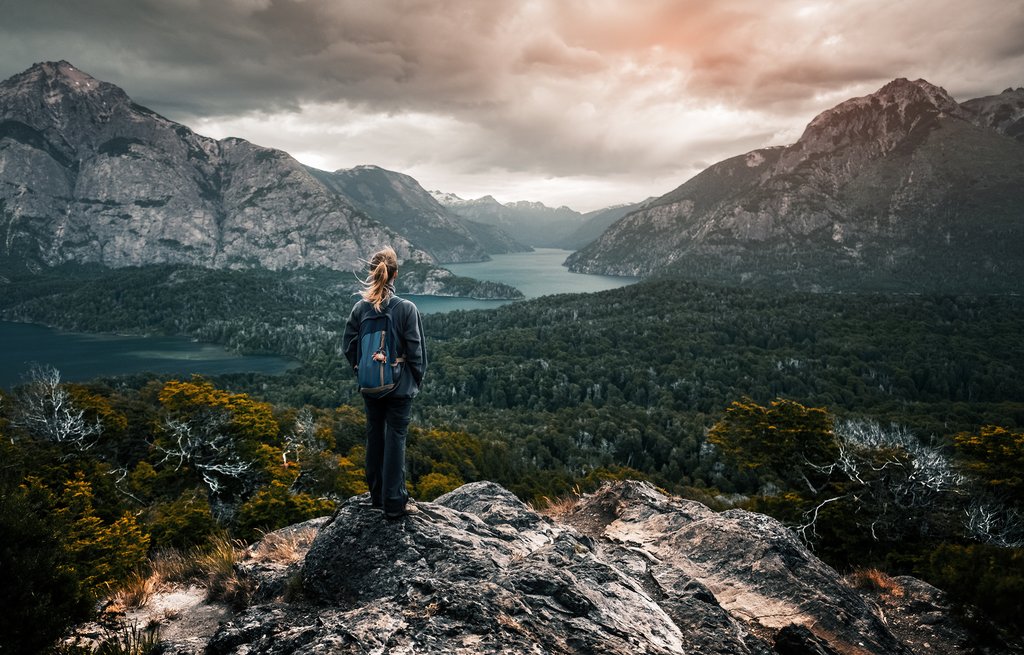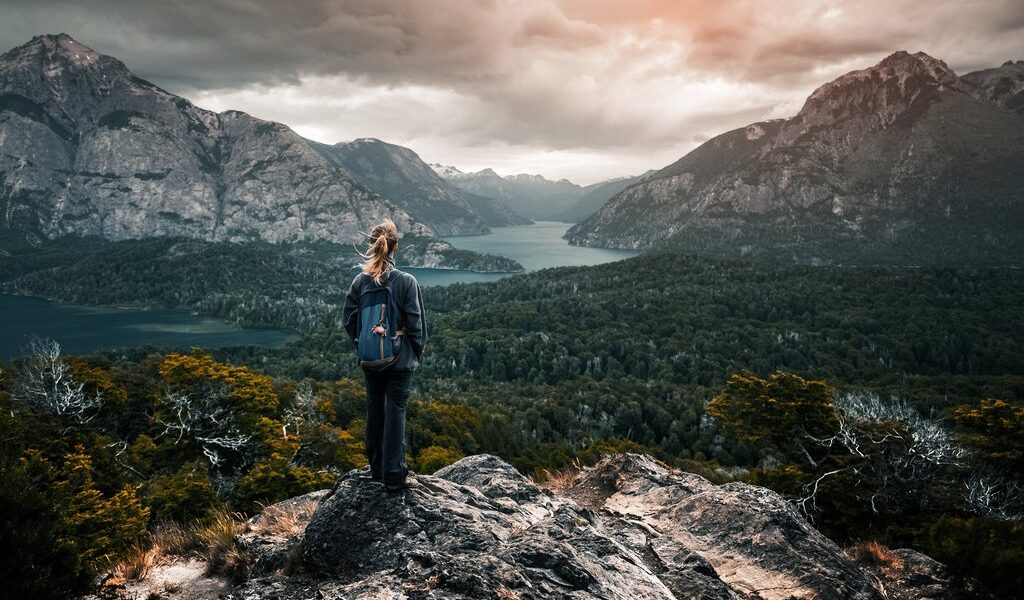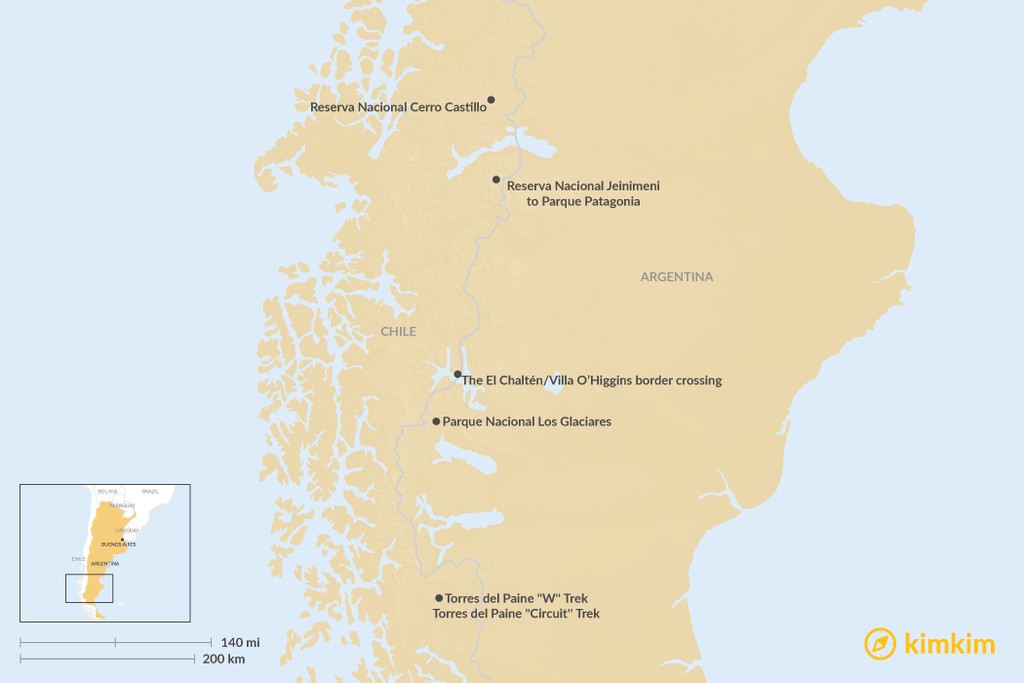
The mountains, forests, glacial lakes and pampas of Patagonia offer tremendous long-distance trekking opportunities. Both Chile and Argentina are represented here, as the treks sometimes meander over the border of these two countries. In addition, a number of trails in Chile’s national parks are part of the Sendero de Chile, a network of trails that spans the length of the country. Below are the best treks in both Chilean and Argentinian Patagonia.
## Patagonia: A Hiker’s Paradise Unveiled
Patagonia, a land of breathtaking beauty and untamed wilderness, stretches across a vast expanse of over 1 million square kilometers. This mesmerizing region encompasses the southern reaches of both Chile and Argentina, a geographical tapestry woven with the towering peaks of the Andes Mountains to the west and the boundless expanse of the Atlantic Ocean to the east. Within this dramatic landscape, a world of trekking adventures awaits, offering a diverse range of experiences from challenging high alpine ascents and demanding mountain passes to serene, sea-level trails that meander past colossal, awe-inspiring glaciers.
Many travelers who venture into the southern portion of Patagonia choose to combine their explorations of Chile’s renowned **Torres del Paine National Park** with equally captivating visits to Argentina’s **Parque Nacional Los Glaciares**. It is important to remember that gaining direct access to Chile’s **Parque Patagonia** from Argentina, following the picturesque but often less-traveled RN41, necessitates the use of a robust 4WD vehicle, ensuring a safe and reliable journey through the rugged terrain.
**Expert Tip:** To truly immerse yourself in the wonders of Patagonia, it is advisable to focus on either the northern or southern region, allowing for a more in-depth exploration of its unique characteristics. Attempting to cover both regions with limited time can result in a superficial experience, preventing you from fully appreciating the nuances of each area. Instead, dedicate your time to uncovering the hidden gems and iconic landmarks that define either northern or southern Patagonia.
## The Majestic “W” Trek in Torres del Paine National Park (Chile)
**Torres del Paine National Park**, widely regarded as one of South America’s most magnificent national parks, spans an impressive 1124 square miles. The park is dominated by the iconic granite towers that lend it its very name, a testament to the powerful forces of nature that have sculpted this remarkable landscape.
The park’s mountains, pristine lakes, expansive glaciers, and dense forests are all readily accessible, thanks to the presence of two well-established long-distance hiking routes: the “W” trek and the “Circuit” trek. Both routes boast excellent infrastructure, offering a range of accommodation options to suit different preferences and budgets. Trekkers can opt to stay in comfortable *refugios* (lodges), which provide well-appointed dormitories and gourmet meals, ensuring a comfortable and convenient experience. Alternatively, for those seeking a more immersive and adventurous experience, camping is permitted along both routes, allowing you to connect with nature on a deeper level.
The famed “W” trek, stretching approximately 43 miles (70 kilometers), traces a route that resembles the letter “W” on the map. This iconic trail takes in the park’s three most prominent highlights: the imposing Glacier Grey, the enchanting French Valley, and the awe-inspiring Las Torres. Completing the “W” trek typically requires around four days, offering a balanced itinerary that allows you to fully appreciate the beauty of each destination.
The day hike from Paine Grande to Glacier Grey is considered relatively gentle, providing a comfortable introduction to the park’s diverse landscapes. In contrast, the middle leg, which leads up the French Valley, presents a more challenging ascent. This steep hike takes you past the hanging Francés glacier, eventually reaching the base of Los Cuernos, the horn-like peaks that are among the park’s most recognizable and distinctive features. From the French Valley, a steep descent skirts the mesmerizing glacial Lake Nordenskjöld, adding another layer of scenic beauty to the trek. Finally, the last leg of the “W” trek involves a demanding ascent of the Ascencio Valley, culminating in a steep scramble up slippery boulders to reach the small lagoon that perfectly reflects the three mighty granite towers, creating a breathtaking panorama.
**Expert Tip:** Given the immense popularity of the **Torres del Paine National Park**, it is essential to book all accommodations, including *refugios* and campsites, weeks or even months in advance to secure your preferred lodging and avoid disappointment. Online booking platforms make it convenient to reserve your spots and plan your itinerary in advance.
## The Grandiose “Circuit” Trek in Torres del Paine National Park (Chile)
The “Circuit” trek, also sometimes referred to as the “O” trek, is an extended adventure that encompasses the “W” trek and completes the loop, covering a total distance of approximately 70 miles (112 kilometers). This comprehensive trek takes you on a journey through diverse landscapes, including back-country hiking through picturesque fields of daisies and dense lenga forests. It also features the challenging ascent to the trail’s highest point, the John Gardner Pass, which rewards you with unparalleled panoramic views of Glacier Grey and the vast Southern Ice Field stretching out beneath you. Throughout the “Circuit” trek, wildlife sightings are common, offering the opportunity to observe guanacos, hares, and even the occasional elusive puma in their natural habitat.
Chat with a local specialist who can help organize your trip.
## Parque Nacional Los Glaciares (Argentina)
The charming town of **El Chaltén** serves as the primary starting point for most hikes within the 4511 square-mile **Parque Nacional Los Glaciares**, Argentina’s renowned national park in Patagonia. While the park offers an abundance of enticing day hikes, it also presents several demanding multi-day treks for experienced adventurers. The classic multi-day trek is the three-day, two-night Monte Fitz Roy/Cerro Torre loop, which showcases breathtaking views of the iconic Mt Fitz Roy, soaring to a height of 11,302 feet (3445 meters).
For those seeking a more challenging experience, the Circuito Los Huemules offers a five-day loop that skirts Laguna Toro, climbs up to Paso del Viento and Paso Huemul, rewarding you with unparalleled views of Glaciar Viedma before descending to the shores of Lago Viedma.
Finally, for the most adventurous and physically fit trekkers, a multi-day trek across Glaciar Marconi offers an unforgettable experience. This trek, accessible only with a certified guide, commences near the Estancia El Pilar (near the Río Eléctrico) and involves at least two nights of camping directly on the Southern Icefield. As such, a high-quality four-season sleeping bag is essential. It is also imperative to pack a sturdy tent and all the necessary supplies for the duration of the trek.
**Expert Tip:** After indulging in your hiking adventures in El Chaltén, consider taking a bus south to El Calafate (a three-hour journey), the southern gateway to the park. From El Calafate, you can visit another unmissable attraction in Los Glaciares: the magnificent Perito Moreno Glacier, a true natural wonder.
## Traversing Reserva Nacional Jeinimeni to Parque Patagonia (Chile)
Located approximately 35 miles southwest of Chile Chico in Aisén, and accessible only by a reliable 4WD vehicle, the 622 square-mile Reserva Nacional Jeinimeni primarily consists of steppe terrain, punctuated by stunning turquoise highland lakes.
The 3 mile (5 km) **Lago Verde trail** marks the beginning of the challenging four-day, 28 mile (45 km) trek through the captivating **Aviles Valley**, which connects Jeinimeni to **Parque Nacional Patagonia** near Cochrane, heading south along the scenic **Carretera Austral** (central highway). This trek demands wilderness experience and strong navigational skills, as it involves several river crossings and the trail is not consistently well-marked.
The trek culminates at the Stone House campground within **Parque Patagonia**, a rehabilitated 428 square-mile former *estancia* (ranch) where the steppe, highland lakes, forests, and mountains are gradually being restored as a vital wildlife corridor. From the Stone House campground, a further 16 mile (25 km) hike west along the road leads to the park headquarters. Future plans aim to connect Parque Nacional Patagonia to Reserva Nacional Tamango, situated near the town of Cochrane, paving the way for an even more extensive and rewarding trekking experience.
As of January 29, 2018, Reserva Nacional Jeinimeni, Parque Patagonia, and Reserva Nacional Tamango have been officially combined to form one vast national park, encompassing 1015 square miles, an area 1.5 times larger than Torres del Paine, Chile’s most famous and most-visited national park. However, during the 15-month transition period, the three park sectors will continue to be known by their original names.
## Embarking on the El Chaltén/Villa O’Higgins Border Crossing (Argentina/Chile)
Currently, there is no road directly connecting Argentina’s legendary Ruta 40 with Chile’s equally iconic Carretera Austral (Southern Highway). Consequently, the fastest way to traverse from one to the other involves crossing the border on foot.
From **El Chaltén**, arrange transportation to **Lago del Desierto**. From there, you have the option of either taking a boat across the lake or embarking on a 7 mile (12 km) hike through the dense forest that fringes its shores. Upon reaching the Argentinian border post, ensure you have your passport stamped for departure. Continue your journey through the lenga forest that stretches through no man’s land until you reach a sign that welcomes you to Chile. From this welcoming sign, a gravel road gently descends to the vast, glacial **Lago O’Higgins**.
The trail from the Argentine border post to the Chilean border post at **Candelario Mancilla** spans a distance of 14 miles (22 kilometers). You may need to spend the night at Candelario Mancilla, either camping or staying in one of the limited number of rooms available, before being picked up by boat the following day. The boat will then transport you to **Villa O’Higgins** via the immense, glacial Lago O’Higgins. Given that the boat’s operation is heavily reliant on weather conditions, it is advisable to pack extra food supplies in case you find yourself stranded for a day or two.
## Discovering the Untamed Beauty of Reserva Nacional Cerro Castillo (Chile)
Reserva Nacional Cerro Castillo, a mountain reserve spanning 1118 square miles, serves as a sanctuary for the elusive huemul deer. The reserve is characterized by its glacier-flanked, needlepoint basalt spires, creating a dramatic and captivating landscape that sees relatively little hiker traffic. If you embrace the challenge of the 25 mile (40 km), four-day **Sendero Cerro Castillo**, you are likely to have the forests and lagoons all to yourself, offering a truly immersive and solitary experience.
The trek commences at the Km75 marker of the **Carretera Austral**, situated at the northern end of the reserve. The trail follows the **Rio La Lima** through dense forest, eventually revealing the gorgeous **Laguna Cerro Castillo** and stunning glacier views along the way. The trail then descends to **Villa Cerro Castillo**, a picturesque village nestled amid lush meadows and majestic mountains. The 4757 ft (1450 m) pass represents the main challenge of the trek, coupled with the poor trail markings. Backcountry camping is the only accommodation option available, adding to the adventurous nature of this remarkable journey.


